My Car Is Leaking Oil From The Front: What Could Possibly Go Wrong?
The most likely cause of oil leaking from the front of your car is a cracked oil pan underneath that may happen if you accidentally hit a rock or some road debris. The oil pan gasket sealing the pan can also degrade over time and start leaking. Other common sources for front oil leaks are a damaged valve cover gasket, leaking oil pump seal, worn out oil cooler, or a leaking rear main seal. Sometimes the leaking fluid may look to you like oil but could be brake fluid leaking instead, as both tend to be the same color.
As a car owner, you may sometimes see oil leaking from the front of your vehicle. This is not unusual for cars.
There are many parts up front that could start leaking oil. These include the oil filter gasket and oil pan. When oil leaks from the front, it’s vital to find the reason why.
In this article, we’ll explore what makes cars leak oil from the front. We’ll also learn some ways to find and fix the leak.
If you have recently changed oil and it started leaking, I have written a detailed guide on that topic as well.
For you, I’ve built an interactive tool that helps diagnose car faults. It takes you through easy-to-follow steps. Be sure to use it.
- Degraded oil pan gasket, cracked oil pan, or warped mating surface can cause oil to leak from the front.
- Improperly installed or damaged oil filter/gasket allows oil to escape and leak.
- Failed seals on oil cooler, often found on sports/heavy duty vehicles, leads to leaks.
- Leak near transmission bell housing may signal damaged rear main engine seal.
- Leaking brake fluid or CV joint grease can resemble an engine oil leak up front.
What is My Personal Experience With Oil Leaking From Car’s Front?
Once my uncle called concerned about an oil leak on his 2015 Toyota Camry. When I looked under the hood, I noticed oil dripping down near the front. After cleaning the area, I found the source was a degraded oil pan gasket.
I removed the old gasket, cleaned the mating surfaces, applied a new bead of RTV sealant, and installed an OEM pan gasket. The quick fix only cost $15 in parts. My uncle was relieved I diagnosed the problem and he didn’t have to pay a mechanic.
Visual Inspection Of Oil Leak
Before diving into the reasons why oil is leaking from the front, it’s important to double-check that the fluid you see is actually engine oil. Sometimes, it can be easy to confuse engine oil with other types of fluids like transmission oil, brake oil, or coolant.
So, if the color of oil leaking from the front is:
- Brown/golden or black: It indicates engine oil.
- Blue, orange, or green: It indicates engine coolant.
- Reddish or red-brown: It indicates transmission oil.
- Brake oil: Almost the same color as engine oil i.e. beige or yellow color. It also gets dark brown/black with time.
- Power steering fluid: In hydraulic steering, a fluid is used to transfer power from the steering wheel to the front wheels. The color of the power steering fluid is red, pink, or amber.
Moreover, if your vehicle is front-wheel drive, it has a CV axle that transfers power from the transmission to the front wheels. CV boots are filled with grease. So, if a CV boot cracks, you can see grease around the front wheel and confuse it with the oil.
Is It Safe To Drive With An Oil Leak?
If your car has an oil leak, you gotta be real careful before driving it. The engine needs oil to work right. Oil keeps all the engine parts slick. Without enough oil, the parts will get too hot. Then they can break down fast.
So if your car has an oil leak, check the dipstick first. Make sure the oil level is between the top and bottom marks. If the oil level is too low, do not drive the car.
Also watch the oil pressure gauge. Or light if you have one. Make sure the oil pressure stays in the range suggested by your car’s maker. Low pressure means there’s not enough oil getting to all the parts. So they can overheat and stop working well.
No driving if the oil pressure drops too low! It’s risky because the engine needs that oil to keep everything working smooth.
The oil and pressure let you know if it’s ok to drive a little ways. But get the leak fixed soon as you can. An engine with very low oil or pressure can break down fast. Costly repairs could be on the way!
What Are The Causes Of Oil Dripping From Car’s Front?
Here are the causes of a car leaking oil from the front:
1. Degraded Oil Pan Gasket
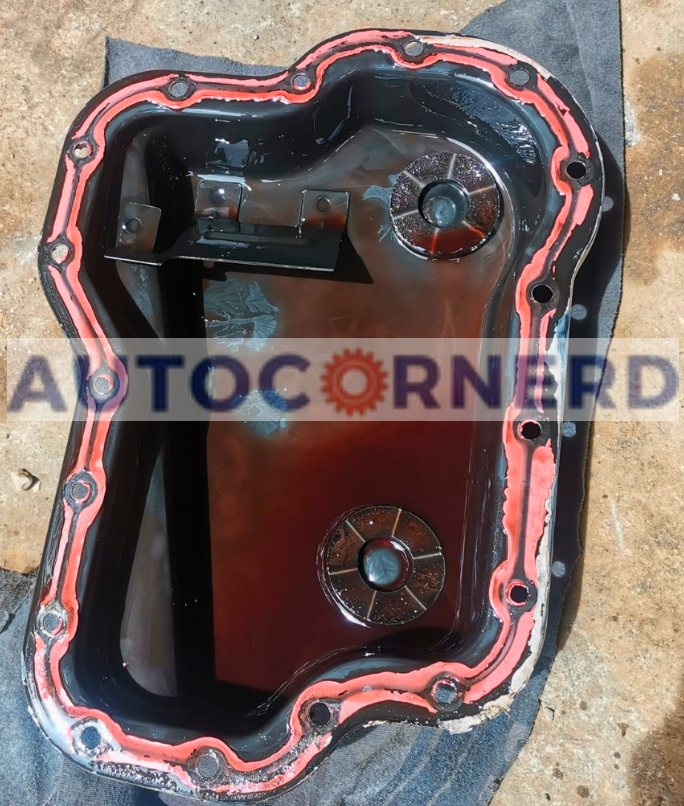
The degraded oil pan gasket is one of the most common reasons for leaking oil from the front of the car.
The oil pan gasket seals the space between the engine block and oil pan. It is made of black rubber or composite material.
Over time, the gasket can get damaged from heat, pressure, oil, and other fluids. Then it can’t keep the oil inside the engine anymore. This causes oil to leak down the engine and out the bottom of the car.
How to fix?
Always use the gasket model recommended by the manufacturer. Cheap oil pan gaskets from other companies often don’t work well.
Before installing the new oil pan gasket, use engine degreaser to clean the oil pan’s surface that will touch the gasket. This removes dirt, old gasket pieces, oil, and anything else that could stop the new gasket from sealing tightly. Proper cleaning here is very important.
If the oil pan is chrome-plated, also scrub out the drain hole threads with a brush. Lightly tap around the bolt holes too to knock loose any debris.
After cleaning, put a thin bead of RTV silicone sealant on the gasket to glue it to the oil pan. Don’t use too much. Gently press the gasket to the pan and wait for the adhesive to set. Check that the gasket doesn’t move – if it slides, wait longer for the sealant to harden.
2. Oil Pan Is Cracked Or Mating Surface Is Warped
The oil escapes through cracks when the oil pan is damaged. Finding leaks under the front tells of harm.
Hitting rocks or things on roads commonly cracks oil pans. When the car passes over the object, the force of impact can damage the oil pan and cause it to crack.
Hitting the oil pan’s bottom can also warp its sealing face. As a result, gasket will not properly seal the gap between the engine block and the mating surface
How to check?
Check for warp of the mating surface of the oil pan with a straight edge. Start by laying the straight edge along the flange that contacts the engine block.
If over 0.1 millimeter gapped, it be warped. Bend, pound, or hammer to flatten.
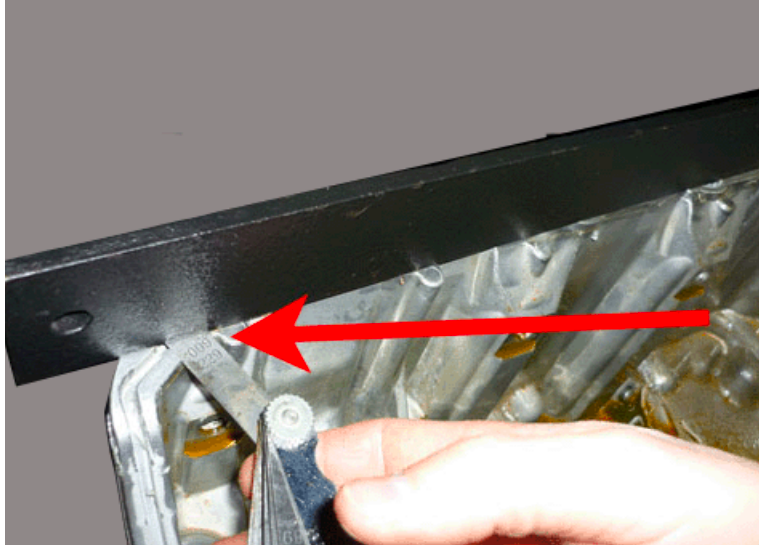
3. Oil Filter Is Not Properly Tightened Or Oil Filter Gasket Is Damaged
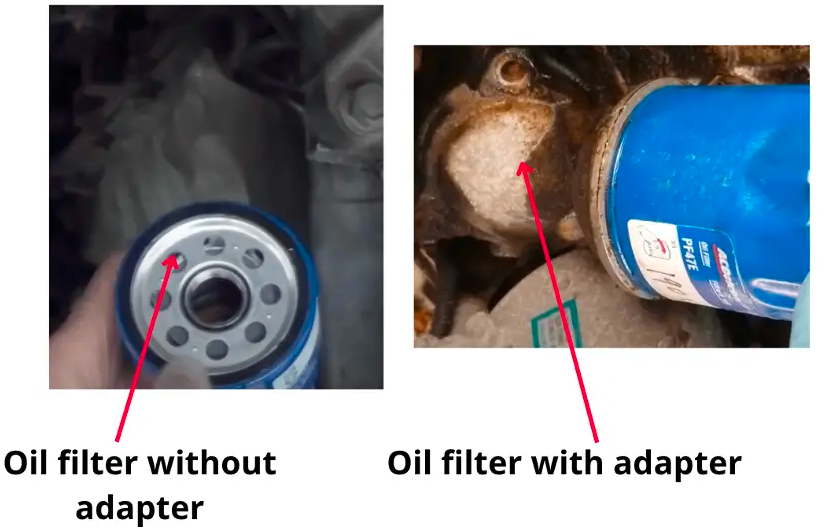
The oil filter can get clogged with dirt and stuff over time. Then oil can’t flow right through the filter. Oil could leak from it.
If the oil filter isn’t put on right, oil can leak out around it. This happens when the oil filter doesn’t seal well.
How the oil filter fits depends on the engine type. In some engines, the filter screws into the engine block using an adapter. In other engines, the filter bolts right to the block.
There’s an important step people often miss when changing the filter. You gotta remove the old gasket from the block. If you leave it there and use two gaskets when you put on the new filter, they could both blow out from the pressure. That would cause an oil leak up front.
That’s why you gotta take the extra time to get the old gasket off and only use one.
Sometimes the old gasket sticks to the block where the oil filter goes on. So you need to check for that.
You can check out the below video from 5:00 time. That guy has explained in detail about the leakages through the oil filter.
4. Oil Cooler Seal Is Damaged
Ordinary cars do not have oil coolers. In regular vehicles, oil is naturally cooled when it flows from the engine back to the oil sump.
As the oil passes through the engine, it will cover areas that are cooler than the oil itself, and thus, heat is given up in the process. On entering the sump, the oil does not stay there for long but continues to transfer heat through the sump pan.
However, in sports vehicles and heavy-duty vehicles used for towing, an oil cooler is used to maintain the temperature of the oil. Such vehicles have very high oil pressure. So, chances are that the oil leaks through the seal of the oil pump.
Engine oil can either leak through
- Oil cooler
- Oil cooler seal between cooler and engine
Many people also confuse that the liquid leaking from the oil cooler is engine oil or coolant. The oil cooler is trapped in the bath of an engine coolant. So, if housing of oil cooler is damaged, the chances are that coolant is leaking.
How to spot oil leak from oil cooler?
To test oil cooler, remove it from the engine. Put it in a bowl of water, and pass air through the opening of the cooler. If air bubbles come out, it means you have to replace oil cooler.
Next, you should check two o-rings at the inlet and outlet of the oil cooler. If they are damaged, you should replace them.
5. Rear Main Seal Is Damaged
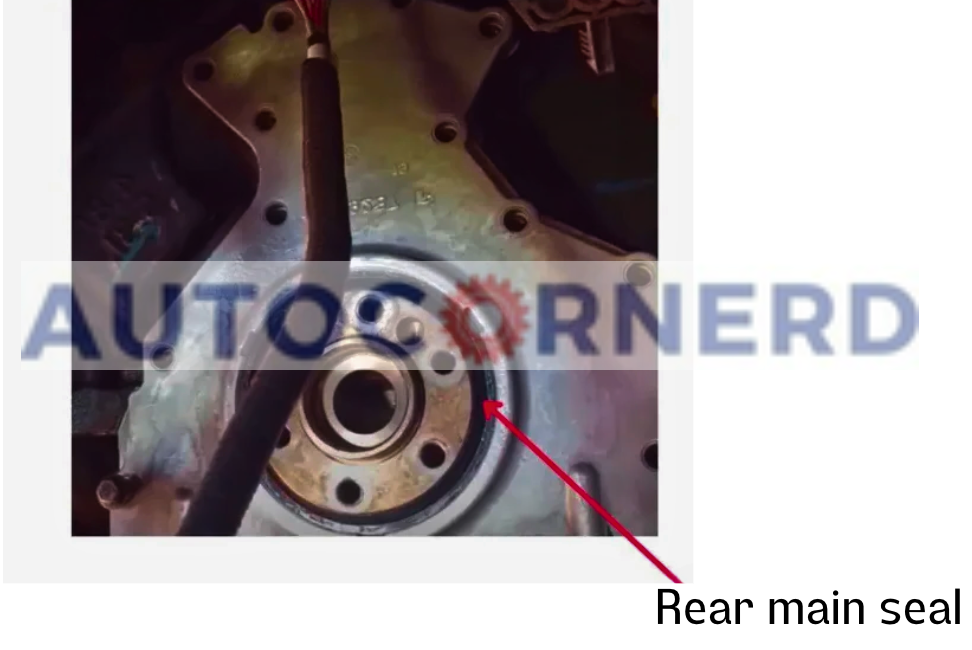
The rear main seal is the part of the engine where the transmission connects to the crankshaft. This seal is at the back of the engine, where the crankshaft exits the engine block.
If oil leaks near the transmission bell housing area at the front of the car, it likely means the rear main seal is the culprit.
The rear main seal is made of rubber, which can start to wear down over time. It can also become brittle, dry, harden and crack from extreme temps, or get damaged by debris in the oil.
Taking off the rear engine cover takes quite a while. Sometimes the whole engine and transmission need to come out first.
6. Cracked CV Boot
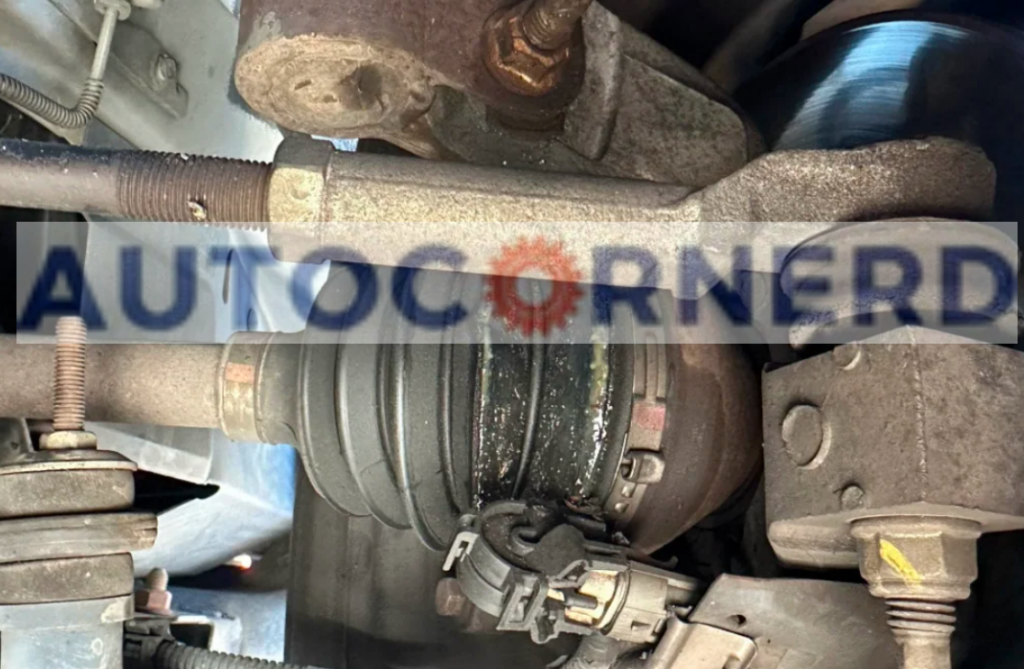
CV boots, also known as Constant Velocity boots, are flexible rubber boots affixed to the Constant Velocity joints at either end of the axle shafts. They prevent dirt and debris from entering the CV joint.
CV rubber boots enclose the grease to lubricate the bearings. When they become brittle and crack, the grease can escape and spatter on the ground beneath the car. This can appear to be an engine oil leak.
How to spot grease leaking from CV boots?
The most obvious sign of CV boot failure is grease leaking from the boot. You may also hear a clicking or rattling noise when turning or accelerating, as the CV joint moves within the boot.
If you observe grease behind the front wheels of your car, the chances are that the CV boot is cracked.
Bonus Read: Can a bad CV joint damage transmission
7. Brake Oil Is Leaking
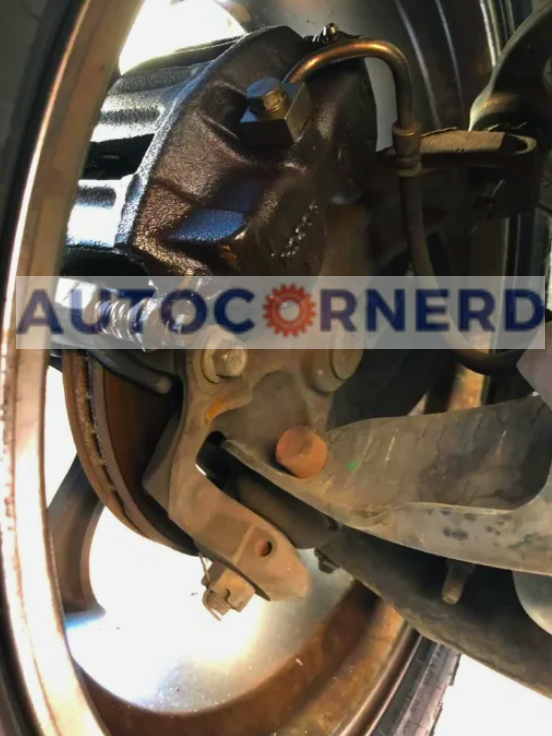
Your car’s brakes need brake fluid to work properly. Brake fluid helps apply pressure to the brakes when you press the brake pedal down. It flows through the brake lines to the brake calipers. This is what makes your brakes work.
If your brake fluid is leaking, your brakes won’t work right. The leak can be hard to see because new brake fluid and engine oil look a lot alike. So if you see oily liquid under the front of your car, check if it’s engine oil or brake fluid.
Where can brake fluid leak from?
It can leak from:
- The ABS pump
- The bleeder valve
- The brake piston seal
- The brake lines
- The master cylinder
The bleeder valve is a small threaded valve on the brake caliper. It lets air and fluid out of the brakes. If the bleeder valve is damaged, it can leak brake fluid. There’s one bleeder valve on top of each brake caliper. They are usually covered with a little rubber cap.
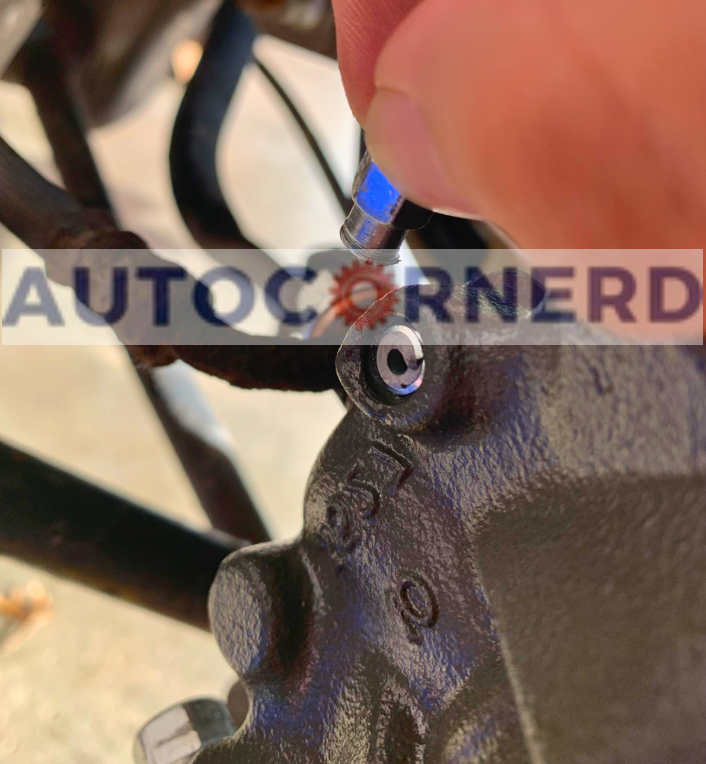
All these parts are at the front of your car. Look at each one to find the leak.
First, clean the area where the leak is with brake cleaner and a rag. Wait and watch to see exactly where it’s coming from. You can put cardboard underneath to help spot the leak.
8. Valve Cover Gasket Is Damaged
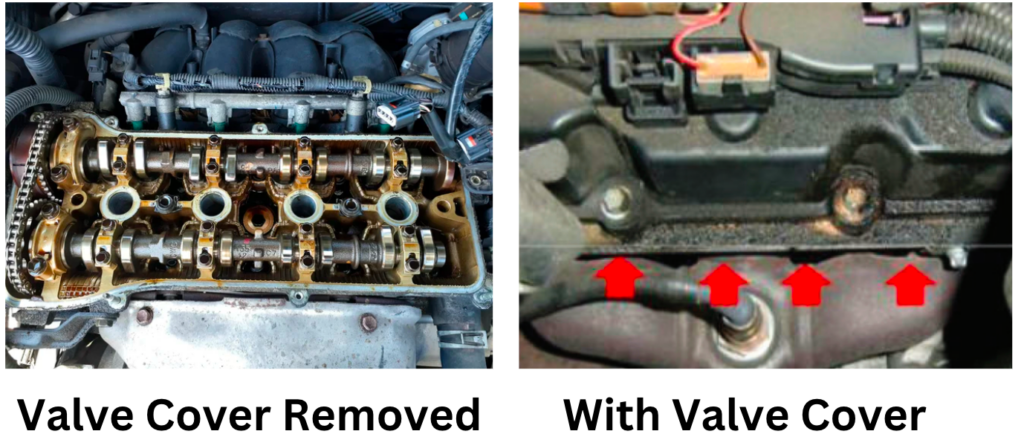
The valve cover gasket is a very important part in a car’s engine. It seals the gap between the valve cover and cylinder head. This stops oil from leaking out.
In the picture above, there are two photos. One shows the valve cover on, the other shows it off. When on, the valve cover encloses camshafts inside the cylinder head.
Oil helps the camshafts work smoothly. It reduces friction between the cams and valves they control.
The gasket keeps the valve cover secure. This stops oil from leaking out. Unfortunately, gaskets can wear out over time. Then they lose protection.
Too much heat also damages gaskets. Heat makes them expand and contract. This causes cracks or tears.
Some engines use plastic valve covers instead of metal. Plastic covers get tiny cracks from the heat. These happen over time.
How Much Does It Cost To Fix An Oil Leak?
| Causes of Oil Leak | Approximate Range of Cost |
|---|---|
| Damaged Oil Pan | $150 – $900 |
| Faulty Gasket | $200 – $1,000 |
| Cracked Engine Block | $1,000 – $5,000 |
| Worn Piston Rings | $1,500 – $4,000 |
| Faulty Rear Main Seal | $600 – $1,200 |
| Loose or Damaged Oil Filter | $10 – $30 |
| Faulty Valve Cover Gasket | $200 – $1,000 |
Some First Hand Experiences Shared By Users In Different Communities
Our team conducted research across various online communities, forums, and subreddits to gather user comments and opinions on “Oil Leak at Car’s Front“.
User 1 says:
My Mazda MX-5 Miata had an oil leak from the front due to a failing oil pressure sensor. Realized it when the oil pressure warning light came on. Replaced the sensor and no more leaks.
User 2 says:
Experienced this with my GMC Sierra. It was a damaged front main seal. Found out when my oil levels dropped quicker than usual. Had to get the seal replaced to stop the leak.
User 3 says:
My Volvo XC60 started leaking oil from the front. The problem was with the timing cover gasket. I noticed oil accumulation near the engine front. Had to replace the gasket to resolve the issue.
User 4 says:
In my Hyundai Tucson, I noticed oil leakage at the front. It was due to a worn-out valve cover gasket. The engine bay had oil residue, and there was a faint burning smell. Changing the gasket solved the problem.


